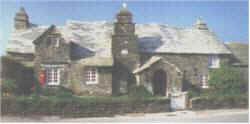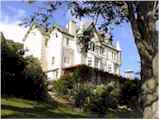

Old Post Office, Tintagel, is one of the most characterful buildings in Cornwall, and a house of great antiquity, this small 14th century manor house is full of charm and interest. Tumble roofed and weathered by centuries, it has been restored in the form of the village post office, that it was for 50 years.
The Old Post Office, Tintagel, was acquired by the National Trust in 1903, and is believed to be only the 5th acquisition that the National Trust made.
Originally built as a small manor house in the 14th century, the building is a rare example of such an early domestic dwelling in Cornwall. The building is typical of many late medieval manor houses, it has a central single-storey hall open to the roof, with smaller service rooms and a kitchen (now the parlour) to its side, and with bedrooms above.
In the late 1800's Tintagel became popular with Victorian tourists, through the Legend of King Arthur poems of Tennyson, Matthew Arnold and Swinburne. Tennyson himself had visited Tintagel in 1848. Many of the original old buildings in the village were torn down, but the Post Office was saved and offered to the National Trust.
Sir Rowland Hill’s Penny Postage in 1840 led to the post reaching remote villages like Tintagel for the first time. Until this time, letters for the village had to be collected from Camelford, five miles away. By 1844 the village and surrounding parish were generating 125 letters per week, so a Letter Receiving Office for the district was established at Tintagel. For this a room was rented from the owner of the old manor house. From the 1870s it was run by William Cobbledick Balkwill, who was also the local draper and grocer.
In 1892 the owner of the house decided to sell it for redevelopment, and the post office moved across the street. By 1895 the building had become derelict and was put up for auction. Catherine Johns, a concerned local artist, bought the building for £300. And sales of prints of pictures by several well-known artists supported the building in 1896. The building was repaired by a leading Arts and Crafts architect, Detmar Blow, according to the guide lines laid down by the Society for the Protection of Ancient Buildings.
And in 1900 the National Trust agreed to buy the building from Miss Johns for a nominal £200, which was raised by public appeal. The purchase was subject to a lease to Miss Johns for her lifetime and the building was acquired by the Trust in 1903. It came to the National Trust without any contents, apart from the late medieval kitchen table in the Hall. The rooms have been furnished by acquiring pieces from farmhouses and cottages in Cornwall.
This small building attracts over 45,000 visitors each year. In 1992 the roof beams were found to be rotten. The original slate roof tiles, were so so heavy they had bent the roof-line. New beams were put in and the original slates put back to retain the character.,
The entrance porch from the main street leads into a passage, with a stone bench on either side.This is very much like the screens passage to be seen in larger domestic buildings from the time. The passage has a door on either side, leading to the Hall and the Parlour, and it opens at the end into what is now a peaceful garden.
The Hall rises through both stories and there is a large slate lintel over the fireplace
The Parlour may originally have been the kitchen, although there are ovens to the side of the fireplaces in both the Hall and the Post Room. The Parlour contains two Windsor chairs and some samplers (girl's embroideries, from the eighteenth and nineteenth centuries).
The two bedrooms are on either wing of the house, reached by separate stairs from the Hall and the Parlour. Off the North Bedroom, above the Parlour, is a gallery, probably a third bedroom, and the slate stairs to reach it are embedded into the wall.
The Post Room is below the South Bedroom and it is equipped as a Victorian village post office. The telegraph reached this remote spot by 1890. The small National Trust shop is now in this room. Outside on the wall is an example of the first standard wall letter box of 1857, of which only 14 such boxes remain in existence. This box is does not have a hood over the letter slot and its door is in the middle.
Old Post Office, Tintagel, National Trust
The hotel to stay at when visiting Cornwall is Corisande Manor Hotel, Cornwall find out more about it
